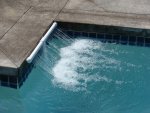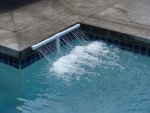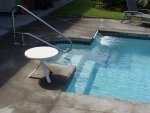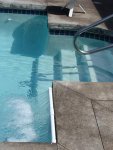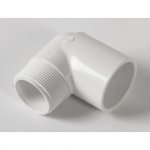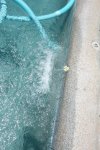- Dec 8, 2012
- 33
- Pool Size
- 14400
- Surface
- Plaster
- Chlorine
- Salt Water Generator
- SWG Type
- Pentair Intellichlor IC-20
sixn3is7 posted:
"During full sun, with mask and snorkel, I played with the angle of attack from straight down (-90 deg from horizontal) to nice arch (45deg from horizontal). Everywhere generated more/less bubbles but the interesting part was the amount of tiny Micro Bubbles (bubbles so small that they appear as a cloud or haze in the water). -45 deg provided the most Micro Bubbles such that the cloud of bubbles would almost make it to the other side. . . "
I'm still a newbie regarding pool hardware and water conditioning topics, so I've been reading many TFP posts:bowdown:
The most important thing that I have learned to date is that I should only attempt to solve one problem at a time, especially chemical problems. I'm still working diligently on perfecting my testing/balancing techniques. Aeration became interesting, since my pool had largely been idle for YEARS --- I bought a former vacation rental property. My TA ranged 210-330 PPM from 1/1/13 to 12/4/13, a period when pool maintenance was not one of my priorities ---- we just weren't using the pool.
I made pool maintenance a priority at the beginning of 2014 and started down my list. When aeration became my next "to do", I started experimenting with PVC pipe/fittings to add aeration to our pool:
at the beginning of 2014 and started down my list. When aeration became my next "to do", I started experimenting with PVC pipe/fittings to add aeration to our pool:
1- "nice arch (45deg from horizontal)" has won for now
2- "-45 deg provided the most Micro Bubbles such that the cloud of bubbles would almost make it to the other side" is my next build
Everything I've read states that micro bubbles are most important for aeration, so back to the workbench I go
Assessment will follow . . . .
"During full sun, with mask and snorkel, I played with the angle of attack from straight down (-90 deg from horizontal) to nice arch (45deg from horizontal). Everywhere generated more/less bubbles but the interesting part was the amount of tiny Micro Bubbles (bubbles so small that they appear as a cloud or haze in the water). -45 deg provided the most Micro Bubbles such that the cloud of bubbles would almost make it to the other side. . . "
I'm still a newbie regarding pool hardware and water conditioning topics, so I've been reading many TFP posts:bowdown:
The most important thing that I have learned to date is that I should only attempt to solve one problem at a time, especially chemical problems. I'm still working diligently on perfecting my testing/balancing techniques. Aeration became interesting, since my pool had largely been idle for YEARS --- I bought a former vacation rental property. My TA ranged 210-330 PPM from 1/1/13 to 12/4/13, a period when pool maintenance was not one of my priorities ---- we just weren't using the pool.
I made pool maintenance a priority
 at the beginning of 2014 and started down my list. When aeration became my next "to do", I started experimenting with PVC pipe/fittings to add aeration to our pool:
at the beginning of 2014 and started down my list. When aeration became my next "to do", I started experimenting with PVC pipe/fittings to add aeration to our pool:1- "nice arch (45deg from horizontal)" has won for now
2- "-45 deg provided the most Micro Bubbles such that the cloud of bubbles would almost make it to the other side" is my next build
Everything I've read states that micro bubbles are most important for aeration, so back to the workbench I go

Assessment will follow . . . .


